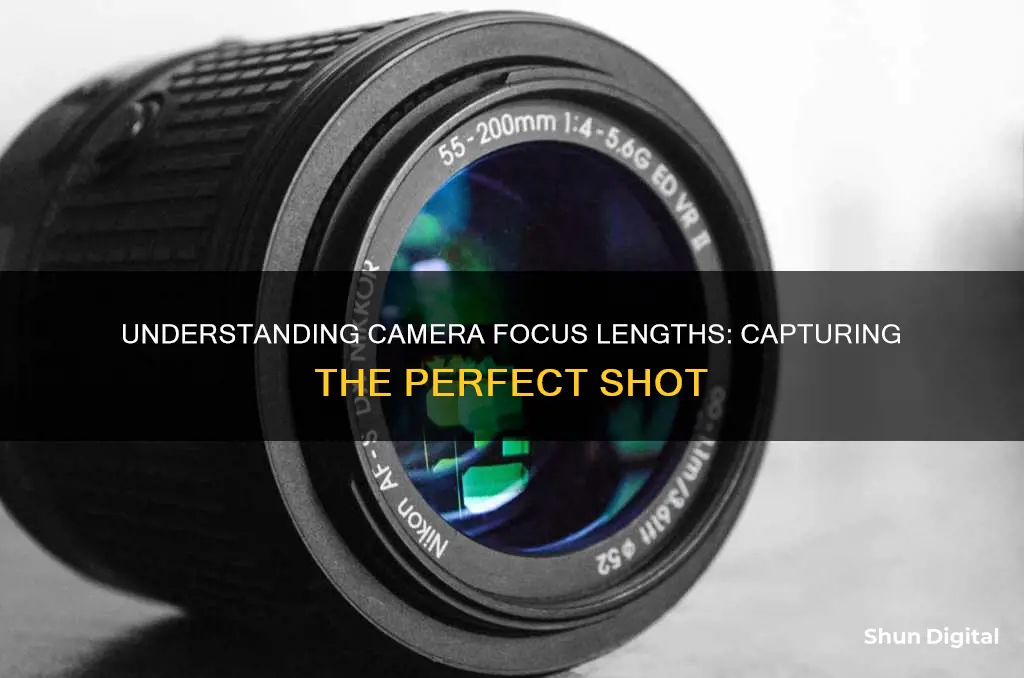
Focal length is a fundamental concept in photography, referring to the distance in millimetres between the optical centre of a camera lens and its sensor. This distance, also known as the optical distance, is calculated from the point where light rays converge to form a sharp image on the sensor. Focal length is not a measure of the physical length of the lens but rather its ability to capture a wide or narrow angle of view. Lenses with shorter focal lengths, such as 18mm, offer a broader field of view, while longer focal lengths, like 200mm, provide narrower angles.
| Characteristics | Values |
|---|---|
| Definition | Focal length is the distance in millimeters between the optical center of the lens and the camera sensor. |
| Calculation | Focal length = the distance from the subject to the lens + the distance from the lens to the camera sensor |
| Lens Focal Length vs Camera Focal Length | Camera focal length is based on a 35mm sensor size. Most full-frame cameras have equivalent sensors. In crop sensor cameras, the image is magnified by 1.5x or 1.6x. |
| Types of Lenses | Prime lenses have a fixed focal length; zoom lenses have variable focal lengths. |
| Angle of View | Longer focal lengths have a narrower angle of view; shorter focal lengths have a wider angle of view. |
| Magnification | Longer focal lengths have higher magnification; shorter focal lengths have lower magnification. |
| Field of View | The focal length impacts the field of view, i.e., how much of the scene is captured by the camera. |
| Distance from Subject | Longer focal lengths are used for distant subjects; shorter focal lengths require the photographer to stand closer to the subject. |
| Distance between Subjects in a Scene | Longer focal lengths compress the distance, making the foreground, middle, and background appear closer together. Shorter focal lengths increase the appearance of distance between planes. |
What You'll Learn

Camera focus length is the distance between the optical centre of the lens and the camera sensor
The focal length of a camera lens is an optical property of the lens. It is the distance, usually measured in millimetres, between the optical centre of the lens and the camera's sensor. This measurement is determined when the lens is focused on something very far away, or focused to infinity.
The focal length is not a measurement of the physical length of a lens, but rather the optical distance from the point where light rays converge to form a sharp image of an object, to the digital sensor or 35mm film at the focal plane in the camera. The focal length of a lens is determined when the lens is focused at infinity.
The focal length of a lens is important because it determines the lens's field of view, or how much of a scene will be captured. It also determines the magnification, or how large individual elements within the scene will be. The longer the focal length, the narrower the angle of view and the higher the magnification. Conversely, the shorter the focal length, the wider the angle of view and the lower the magnification.
The focal length of a lens is also important because it affects the distance between the photographer and the subject. Objects will appear smaller in images taken with short focal length lenses, and larger in those with longer focal lengths. Additionally, longer focal lengths compress the distance between the foreground, middle, and background, making them appear closer together. Shorter focal lengths increase the appearance of distance between these planes.
Lenses are named by their focal length, which can be found on the barrel of the lens. For example, a 50mm lens has a focal length of 50 millimetres. This is true regardless of the camera being used, whether it is a full frame, cropped sensor, or medium format camera. However, the size of the camera sensor will affect how the photos look at a particular focal length.
Lightroom Presets: Importing into Camera Raw
You may want to see also

It is measured in millimetres
Focal length is the basic description of a photographic lens, and it is usually measured in millimetres (mm). It is not a measurement of the actual length of a lens but a calculation of the optical distance from the point where light rays converge to form a sharp image of an object to the digital sensor or 35mm film at the focal plane in the camera. This distance is measured in millimetres.
The focal length of a lens is determined when the lens is focused at infinity. It tells us the angle of view—how much of the scene will be captured—and the magnification—how large individual elements will be. The longer the focal length, the narrower the angle of view and the higher the magnification. Conversely, the shorter the focal length, the wider the angle of view and the lower the magnification.
A lens with a focal length of 50mm provides a field of view that is approximately the same as the field of view produced by the human eye. Lenses with focal lengths close to 50mm (typically considered to be between 35mm and 70mm) are known as "normal" or "standard" lenses.
Lenses with focal lengths shorter than 50mm are considered wide-angle lenses, and those with focal lengths longer than 50mm are considered telephoto lenses. Wide-angle lenses provide a wider angle of view than standard lenses, while telephoto lenses provide a narrower angle of view and higher magnification.
Challenging a Camera Ticket: What You Need to Know
You may want to see also

It determines the angle of view
The focal length of a camera lens determines the angle of view, or how much of a scene will be captured by the lens. The focal length is the distance, usually measured in millimetres, from the point where light rays converge to form a sharp image of an object to the digital sensor in the camera.
A longer focal length results in a narrower angle of view and higher magnification, while a shorter focal length provides a wider angle of view and lower magnification. This means that a lens with a short focal length will capture a broader view, making it ideal for landscape shots or environmental portraits. Conversely, a lens with a longer focal length will have a smaller angle of view, making it better suited for capturing distant subjects or close-ups of specific details.
The angle of view can be described as the area of the scene that is captured by the camera sensor, typically given in degrees of coverage in front of the camera. It is also sometimes referred to as the field of view. In practical terms, the angle of view and field of view are often used interchangeably in photography to describe how our cameras "see" the scene.
The focal length of a lens also influences the perspective and depth of field in an image, which can greatly affect its overall expression. Lenses with shorter focal lengths tend to magnify objects in the foreground while diminishing the perspective of background elements. On the other hand, longer focal lengths result in a more "compressed" image, allowing you to capture distant subjects without sacrificing image quality.
It is worth noting that the angle of view is also influenced by the camera's sensor size. A larger sensor will yield a larger field of view for the same focal length. Additionally, the crop factor or focal length multiplier further complicates the relationship between focal length and angle of view, especially when using cameras with different sensor formats.
Focusing on Eyes: Glasses and Camera Tips
You may want to see also

Longer focal lengths = narrower angle of view
The focal length of a lens is the distance from the point where light rays converge to form an image to the camera's sensor. This is usually measured in millimetres (mm). The longer the focal length, the narrower the angle of view.
How Focal Length Affects Angle of View
A longer focal length results in a narrower angle of view, meaning the lens can capture less of a scene. This is because the longer the focal length, the more the light is bent gradually. In photography, this means that a longer focal length will bring distant objects closer, resulting in a narrower field of view.
Examples of Longer Focal Lengths
Telephoto lenses are an example of lenses with longer focal lengths. These lenses typically have focal lengths of 85mm or more and are often used for photographing distant subjects such as in wildlife or sports photography. Super telephoto lenses have even longer focal lengths, ranging from 300mm and above.
How to Calculate Focal Length
To calculate the focal length, you need to know the distance from the subject to the lens and the distance from the lens to the camera sensor. The formula for calculating focal length is:
> Focal length = distance from subject to lens + distance from lens to camera sensor
It's important to note that the focal length of a lens is different from its physical length. The focal length is an optical measurement that describes how light is bent by the lens, while the physical length of the lens is simply the size of the lens itself.
Prime vs. Zoom Lenses
Lenses can be categorised into two types: prime and zoom. Prime lenses have a fixed focal length, meaning the photographer cannot zoom in or out. Zoom lenses, on the other hand, have variable focal lengths, allowing the photographer to adjust the focal length and, consequently, the angle of view.
The Chemistry of Camera Batteries
You may want to see also

Shorter focal lengths = wider angle of view
The focal length of a lens is the distance between the optical centre of a lens and the image sensor. This distance is measured in millimetres (mm) and determines the angle of view, or field of view, of the lens. The angle of view is the area of a scene that the camera's sensor captures.
A shorter focal length results in a wider angle of view. This means that the area captured by the camera is large, but the subject appears smaller within the frame.
For example, a lens with a focal length of 18mm will have a wider angle of view than a lens with a focal length of 200mm.
Shorter focal lengths are ideal for capturing sweeping landscape shots or environmental portraits, where it is important to capture a wide view of the setting as well as the subject. They are also useful for large group portraits, architectural photography, and capturing expansive vistas in landscape photography.
Lenses with shorter focal lengths are typically smaller and lighter than those with longer focal lengths. They also tend to have larger maximum apertures, which allow more light into the camera and enable photographers to shoot at higher shutter speeds.
Technical Details
The relationship between focal length and angle of view can be described by the equation:
$$ AFOV = 2 \times \tan ^{-1} { \left( \frac{H}{2f} \right)} $$
Where AFOV is the angular field of view, H is the sensor size, and f is the focal length.
This equation shows that for a given sensor size, a shorter focal length will result in a wider AFOV.
Additionally, a shorter focal length will require a shorter distance to obtain the same field of view as a longer focal length lens.
Maintain Original Ratios in Camera Raw: A Simple Guide
You may want to see also
Frequently asked questions
Focal length is the distance, usually measured in millimetres, between the optical centre of the lens (where light converges) and the camera's sensor.
Focal length determines the angle of view, or how much of the scene will be captured. A shorter focal length will give you a wider angle of view, while a longer focal length will result in a narrower angle of view and higher magnification.
Prime lenses have a fixed focal length, meaning you cannot zoom in or out. Zoom lenses, on the other hand, have variable focal lengths, allowing you to capture a range of focal lengths without changing lenses.
The choice of focal length depends on the type of photography you want to do. For example, wide-angle lenses (short focal length) are great for landscapes and architecture, while telephoto lenses (long focal length) are ideal for sports, wildlife, and portrait photography.







